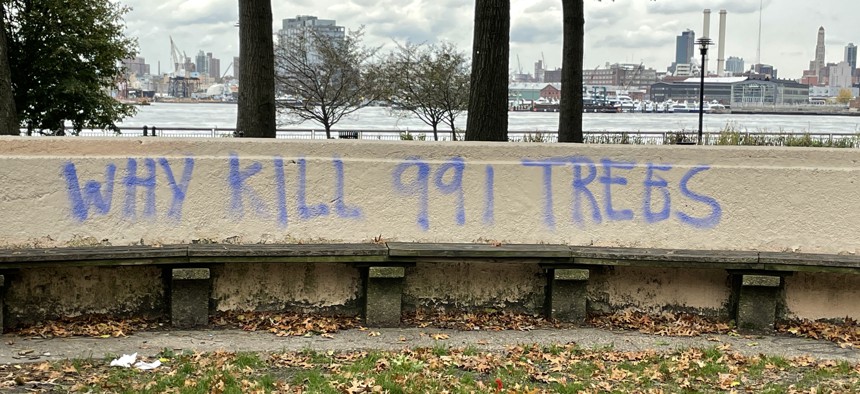Work on an unprecedented flood prevention project, which was developed after Superstorm Sandy in 2012, has resumed in New York City’s East River Park after a temporary restraining order was lifted by an appellate court.
The $1.45 billion project, deftly titled the East Side Coastal Resiliency Project ceased a work stoppage after members of various community organizations sued the city over the effect the demolition would have on the public. “The city really lied to the community,” said City Council Member-elect Christopher Marte, a co-defendant on the suit, who is now proposing a community plan to save the Manhattan park.
Park space on Manhattan’s East Side was chosen by the city Department of Design and Construction along with the city Department of Parks and Recreation to target areas prone to flooding. They homed in on Stuyvesant Cove Park, Corlears Hook Park, Murphy Brothers Playground and Asser Levy Playground in addition to East River Park in the Lower East Side.
The City Council approved the project in its current form in November 2019, and construction began on Stuyvesant Cove Park’s flood wall. The construction would entail the lifting of the park so it is flood-resistant and can act as a flood barrier for New York City Housing Authority residents who live along the park’s border and the FDR Drive.
“I attended the early (community board) meetings when they were first proposing resiliency for [East River Park]. It was a true community process, asking us what we wanted to protect and what we wanted to see. There was a good final product, but then the city decided to change it,” said Marte.
Various organizations along with block associations and residents on the Lower East Side are suing the city for not getting approval from the state Legislature before starting construction, as well as for alienating the public from using the park for the next several years. In a petition filed to the state Supreme Court, over a dozen petitioners said, “The loss of any part of East River Park to the Resiliency Project would constitute irreparable injury to petitioners and to the community they represent.”
While a nullification of the City Council’s vote is a difficult process, Marte argued that it could be voided based on what he knows of how this current plan came to be. And now, with the overruling by the state Appellate Court, it may be the last remaining avenue for those against the project to take to stop work on the land given construction will start up again immediately and throughout 2022.
“It’s really unprecedented. If more information comes out … and if you undermine the facts and they voted on something that is untrue, they’d have to redraw that and do that vote again,” said Marte.
The information Marte is referring to is the Environmental Impact Statement, or EIS, which he and petitioners allege did not tell the full story of the impact the coastal resilience project would have on the park’s trees, wildlife and surrounding community’s air quality during construction.
When asked what alternatives Marte would propose as the next council member in care of East River Park, he said that the original plan makes the most sense to him and to the community members he has spoken with as it was a “community plan to protect people in public housing.”
“What we realized is that the community plan is cheaper, it protects the park and it has a shorter timeline … Why don’t we go back to the community plan to protect people in public housing and not destroy 1,000 trees?” said Marte.
Marte ran on a platform in support of the overruling on the City Council vote. His campaign’s website states he supports “true flood protection” that saves East River Park.
The first plan by the city was to build a flood wall around the park just as one is being built around other parks and public areas that are a part of the ESCR project, which would have had the same price tag as the current project according to Marte. He also said it would have been a much shorter construction process.
Ian Michaels, a spokesperson for the city Department for Design and Construction, said that Marte’s and others’ allegations of there only being a flood wall, and the original plan being less intrusive of the park and surrounding LES community is “just not true.”
Michaels also stated that the decision to move the flood wall east towards Stuyvesant Cove Park and to raise all of East River Park was based on “several factors related to constructability, long-term sea level rise and the effects of construction on the local community, particularly nearby NYCHA housing.”
“The new plan brings the park itself into the protected zone, while under the old plan, the park remained vulnerable. This is a major benefit considering the likely effects of climate change in the coming years,” said Michaels.
City Council Member Carlina Rivera, who represents City Council District 2, is also wary of “misconceptions” floating around regarding the ESCR project. Rivera, in a statement through email, said that “protest is an integral part of our history [in District 2]. I will always fight to ensure every New Yorker is able to stand up for what they believe in.”
“That said,” added Rivera, “lies and misinformation have caused unnecessary divisiveness when we urgently need flood protection … the community has shared honest criticism, resulting in increased transparency and a better, stronger plan.”
Editor's note: East River Park Action, a group against the current plan for the flood prevention project, reported Wednesday after the publication of this story that a new restraining order was issued, again stopping the demolition of East River Park.
NEXT STORY: Amid tension in the Brooklyn Dems, James sides with Bichotte Hermelyn


